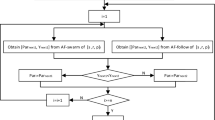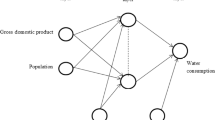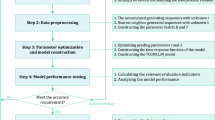Abstract
Although the traditional grey model is an effective method in predicting the water consumption, it is difficult to reflect the sequence of randomness, fluctuation and discreteness. In this study, a prediction model of urban annual domestic water consumption is proposed. AF-MNGBM(1,1) model is established as an optimized nonlinear grey Bernoulli model to select the optimal parameters, by combining a self-adaptive artificial fish swarm algorithm (SAFSA) and the metabolic method. The time series data of Wuhan’s residential water consumption between 1994 and 2017 are used to verify the effectiveness of AF-MNGBM(1,1) in predicting annual water consumption. Meanwhile, the prediction results are compared with those of common NGBM(1,1) model, traditional GM(1,1) model and grey Verhulst model. The results show that the AF-MNGBM(1,1) model has higher prediction accuracy. The optimized model provides a new method in predicting the mid- and long-term annual water consumption with the data of randomness, fluctuation and discreteness in different industries. The model has been applied in the new round water quota modification of Wuhan.







Similar content being viewed by others
References
Ajbar AH, Ali EM (2015) Prediction of municipal water production in touristic Mecca City in Saudi Arabia using neural networks. J King Saud Univ Eng Sci 27(1):83–91
An Y, Zou ZH, Zhao YF (2015) Forecasting of dissolved oxygen in the Guanting reservoir using an optimized NGBM(1,1) model. J Environ Sci 29(1):158–164
Chang C-J, Li D-C, Huang Y-H, Chen C-C (2015) A novel gray forecasting model based on the box plot for small manufacturing data sets. Appl Math Comput 265:400–408
Chen C-I, Chen HL, Chen S-P (2008) Forecasting of foreign exchange rates of Taiwan's major trading partners by novel nonlinear grey Bernoulli model NGBM(1,1). Commun Nonlinear Sci Numer Simul 13(6):1194–1204
Chen ZH, Yuan XH, Ji B (2014) Design of a fractional order PID controller for hydraulic turbine regulating system using chaotic non-dominated sorting genetic algorithm II. Energy Convers Manag 84:390–404
Chi DC, Wang HN, Li X et al (2011) Application of grey metabolism GM(1,1) model in reference crop evapotranspiration prediction. Water Sav Irrig 8:32–35
Deng JL (1984) Theory and method of social economy grey system. Soc Sci China 6:47–60
Eslamian SA, Li SS, Haghighat F (2016) A new multiple regression model for predictions of urban water use. Sustain Cities Soc 27:419–429
Firat M, Turan ME, Yurdusev MA (2010) Comparative analysis of neural network techniques for predicting water consumption time series. J Hydrol 384(1):46–51
Gan YY, Chen X, Fu J, Yuan XM (2012) Municipal water consumption prediction based on the GM(1,1) model. Water Resour Power 30(09):40–42
Gui Z (2013) Typical investigation and water quota standards of business building water consumption. Water Purif Technol 32(3):55–58
Guo LL, Zou ZH, An Y (2014) Application of GM(1,1) model based on residual modification in water quality prediction. Math Pract Theory 44(19):176–181
Hsu L-C (2010) A genetic algorithm based nonlinear grey Bernoulli model for output forecasting in integrated circuit industry. Expert Syst Appl 37(6):4318–4323
Jiang HJ, Fu GW (1990) The grey prediction of water demand. China Environ Sci 10(5):339–342
Jiang JL, Zhou XH (2007) Application research of seasonal exponential smoothing in municipal water consumption prediction. Sci Technol Eng 7(8):1666–1669
Liao DG, Xiong XH (2003) The application of the GM(1,1) metabolism model to error data processing of NC machine tools. Int J Plant Eng Manag 8(2):103–107
Liang J, Yuan XH, Yuan YB (2017) Nonlinear dynamic analysis and robust controller design for Francis hydraulic turbine regulating system with a straight-tube surge tank. Mech Syst Signal Process 85:927–946
Liu L, Wang HG, Wang BW (2009) GM(1,1) model optimization based on the construction of background value. Stat Decis Mak 277(1):153–155
Luo D, Liu SF, Dang YG (2003) The optimization of grey model GM(1,1). Eng Sci 8:50–53
Odan FK, Reis LFR (2012) Hybrid water demand forecasting model associating artificial neural network with Fourier series. J Water Resour Plan Manag 138(3):245–256
Walker D, Creaco E, Vamvakeridou-Lyroudia L et al (2015) Forecasting domestic water consumption from smart meter readings using statistical methods and artificial neural networks. Procedia Eng 119:1419–1428
Wang XD, Xiong W (2010) Dynamic customer demand analysis based on an improved grey prediction model. Syst Eng Theory Pract 30(8):1380–1388
Wang XY, Zhou BP (2010) Mathematical modeling and mathematical experiments. Beijing Science Press, Beijing, pp 1–268
Wen JM, Guo CQ, Li XJ, Li WB (2012) Guilin water demand forecast on ecological city construction based on BP neural network. Resour Prot 28(03):47–50
Yuan XH, Zhang YC, Yuan YB (2008) Improved self-adaptive chaotic genetic algorithm for hydrogeneration scheduling. J Water Resour Plan Manag ASCE 134(4):319–325
Yuan XH, Tan QX, Lei XH (2017) Wind power prediction using hybrid autoregressive fractionally integrated moving average and least square support vector machine. Energy 129:122–137
Yuan YB, Zhao H, Yuan XH, Chen LY, Lei XH (2019) Application of fractional order-based grey power model in water consumption prediction. Environ Earth Sci 78(8):266
You K, Wang WN (2014) River water quality prediction based on NGBM(1,1) model. Green Living 18:102–103
Zhang YJ, Liu QS, Feng CM (2003) The application of multiple linear regression analysis in Beijing domestic water demand prediction. Wastewater Eng 29(4):26–29
Zhou H, Huang J, Yuan Y, Tang B (2014) Prediction of water consumption in hospitals based on a modified grey GM (0, 1|sin) model of oscillation sequence: the example of Wuhan City. J Appl Math. https://doi.org/10.1155/2014/521973
Acknowledgements
This work was supported by the National Natural Science Foundation of China (No. 41571514), the Open Fund of the Hubei Provincial Key Laboratory for Operation and Control of Cascaded Hydropower Station in China Three Gorges University (No. 2019KJX02).
Author information
Authors and Affiliations
Corresponding author
Rights and permissions
About this article
Cite this article
Yuan, Y., Li, Q., Yuan, X. et al. A SAFSA- and Metabolism-Based Nonlinear Grey Bernoulli Model for Annual Water Consumption Prediction. Iran J Sci Technol Trans Civ Eng 44, 755–765 (2020). https://doi.org/10.1007/s40996-020-00366-0
Received:
Accepted:
Published:
Issue Date:
DOI: https://doi.org/10.1007/s40996-020-00366-0




